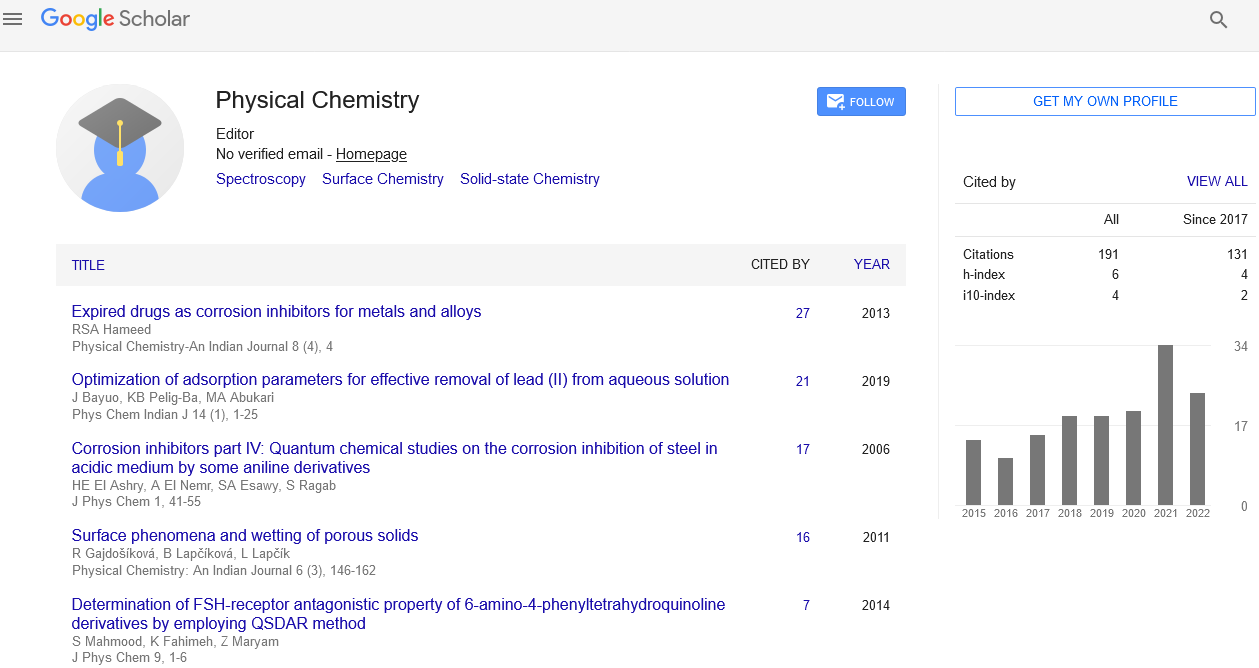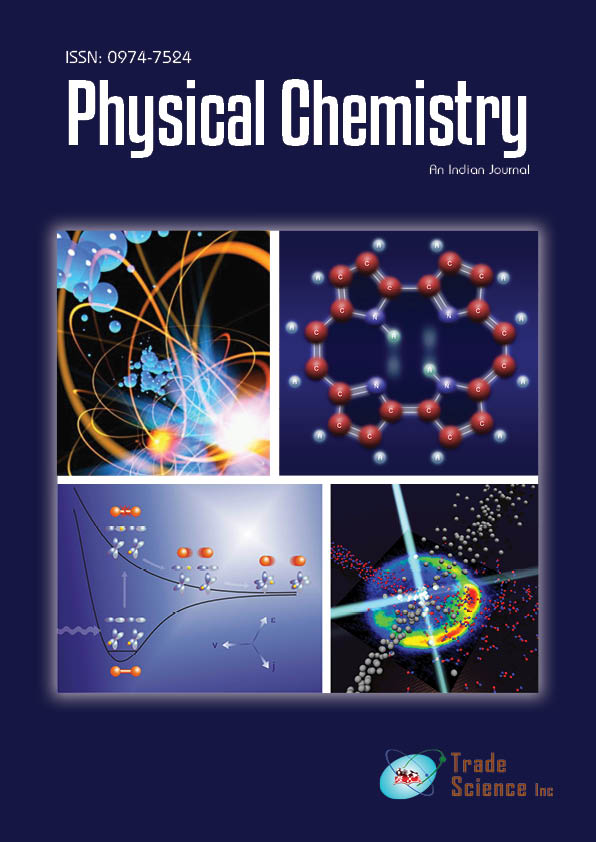Review
, Volume: 15( 1) DOI: 10.37532/0974-7524.2020.15(1).127Is the λ in Marcus Equation a Constant or a Function of ΔGo?
- *Correspondence:
- Xiao-Qing Zhu
State Key Laboratory of Elemento-Organic Chemistry, Department of Chemistry, Nankai University, Tianjin, 300071, China
E-Mail: xqzhu@nankai.edu.cn
Received: January 21, 2020; Accepted: February 04, 2020; Published: February 25, 2020
Citation: Zhu XQ, Chen BL, Li Y. Is the λ in Marcus Equation a Constant or a Function of ΔGo? Phys Chem Ind J. 2020;15(1):127.
Abstract
The fundamental errors of Marcus equation have been discovered for more than 6 years and many literatures on the fundamental errors of Marcus equation have been published, but till now many people have continued to make articles using the incorrect Marcus equation despite the fundamental errors of Marcus equation. Why? In this review article, the main reasons of their mistakes are pointed out.
Keywords
Marcus equation; Intrinsic barrier; Reaction of Lewis acids with Lewis bases; Inverted region; Zhu equation
Introduction
As well known, Marcus equation (Eq. 1) was initially proposed by Rudolph A. Marcus in 1956 to describe the kinetics of the outer sphere electron transfer reactions according to the solvent polarization [1,2]. In Marcus equation, ΔGo is the free energy change of chemical reactions, ΔG≠ is the activation free energy of chemical reactions, λ is the reorganization energy of chemical reactions. After the extension by many chemists [3-7] Marcus equation has been widely used in various chemical reactions. However, If the relationship of ΔG≠ with ΔGo in Marcus equation is examined, it is found that ΔG≠ is a quadratic function of ΔGo for a chemical reaction. Because the quadratic function has two solutions (i.e., two roots) at the same time, a chemical reaction should have one ΔG≠value and two different ΔGo values under given conditions according to Marcus equation. It is clear that Marcus equation is incorrect because each chemical reaction has only one ΔG≠value and one ΔGo value under given conditions. In order to find the fundamental error of Marcus equation, in 2013 we re-examined the premises assumptions of Marcus equation and found that the most important premise assumption of Marcus equation (i.e., the energy parabola of the reactant system and the production system have the same rate of change) directly violates the law of energy conservation [8]. Although the fundamental error of Marcus equation has been discovered for more than 6 years and many papers about the fundamental error of Marcus equation have been reported [8-18], there are still many chemists who use Marcus equation to make papers today [19-32]. Why? After examing the publications made using Marcus equation, we found that the authors of these publications not only did not read our articles on the fundamental errors of Marcus equation but also did not understand Marcus equation. In this short review article, we take an article entitled “Which Factors Control the Nucleophilic Reactivities of Enamines?” by Daria S. Timofeeva, Robert J. Mayer, Peter Mayer, Armin R. Ofial, and Herbert Mayr in Chem Eur J (hereafter referred to as the Mayr’s paper) [19] as an example for reviewing. In Mayr’s paper, the authors calculated the intrinsic barriers (ΔGo≠) of 20 reactions of Lewis acids with Lewis bases in acetonitrile using Marcus equation in order to explain the special nucleophilic reactivities of some enamines. The main mistake of the Mayr’s paper is that the authors took the λ in Marcus equation as a function of the thermodynamic driving force (ΔGo) of reactions rather than a constant, which directly violates the nature of the λ in Marcus equation. Since this kind of error often appears in the recent publications [19-32], it is necessary to reconfirm the nature of the λ in Marcus equation firstly.
 (1)
(1)
The Nature of the λ in Marcus Equation
To reconfirm the nature of the λ in Marcus equation, we first need to know the derivation of Marcus equation. Marcus equation was derived originally for the outer sphere electron transfer reactions [1,3,4]. There are a lot of methods to derive Marcus equation containing the complicated and cumbersome original derivation method reported by Marcus himself [1,2] and some simplified derivation methods reported later [33-35]. By examining the reported methods, it is clear that both the original method and the subsequently simplified methods contain two essential assumptions: the first assumption is that the free (or potential) energy changes of reactant system (reactants plus surrounding medium) and product system (products plus surrounding medium) as a function of the reaction coordinate can be described by using two harmonic oscillators (or parabolas), respectively. The other assumption is that whether the product system and the reactant system are the same or different, the two harmonic oscillators have the same frequency (i.e., the constants (k) of the two parabolas are the same). FIG. 1 is a typical Marcus kinetic model for a chemical reaction described by two parabolas with the same constant (k). In FIG. 1, the left parabola (red) refers to the reactant system (symbolized by R), the right parabola (black) refers to the product system (symbolized by P), the intersecting point refers to the transition state (TS). ΔG≠ is the activation free energy of reactions; ΔGo is the thermodynamic driving force of reactions; a is the change of reaction coordinates between reactants system and product system at the ground state (In general, a=1e charge for electron transfer reactions). G= kr2 is the parabola equation of reactant system (Eq. 2), G= k(a-r)2+ ΔGo is the parabola equation of product system (Eq. 3).
FIG. 1. A typical Marcus kinetic model for a chemical reaction (R → P).
G= kr2 (2)
G= k(a-r)2 + ΔGo (3)
When Eq. 2 and Eq. 3 are solved jointly, we can derive Marcus equation (Eq. 1).
In Eq. 1,
λ= ka2 (4)
Since k and a in Eq.4 all keep constant when ΔGo changes, the λ in Marcus equation, as the α and β in Brønsted equation (ΔG≠ = αΔGo + β), is a constant rather than a function of ΔGo.
In addition, when ΔGo in FIG. 1 move from positive infinity to negative infinity (FIG. 2a), we can get a parabolic line for the relationship of ΔG≠with ΔGo (FIG. 2b), in which λ is constant when ΔG≠ and ΔGo change. If ΔGo of a chemical reaction is greater than -λ, the reaction is in the normal region; if ΔGo of a chemical reaction is smaller than -λ, the reaction is in the Marcus inverted region.
FIG. 2. Relationship between ΔG≠with ΔGo derived from the Marcus kinetic model in which λ is a constant when ΔG≠with ΔGo change.
From the derivation of Marcus equation and FIG. 2, it is clear that the λ in Marcus equation has been reconfirmed to be a constant rather than a function of ΔGo. It is true that if the λ in Marcus equation were not a constant, there would not be Marcus equation and the Marcus’ inverted region.
The Errors of the Mayr’s Paper
For Mayr’s paper, our focus is the method by which the authors calculated the intrinsic barriers (ΔGo≠) of the 20 reactions of Lewis acid with Lewis bases in acetonitrile. From the method applied, we found that the authors took the λ/4 in Marcus equation as the intrinsic barrier of chemical reaction (ΔGo≠) and directly introduced the values of ΔG≠and ΔGo of the 20 reactions into Marcus equation to yield the corresponding intrinsic barriers of the reactions (shown in the Table 7 in the Mayr’s paper) [19]. This method evidently is incorrect, because it is not in line with the nature of the λ in Marcus equation. As well known, the definition (or the meaning) of intrinsic barrier (ΔGo≠) of a reaction is an activation free energy (ΔG≠) of the reaction when the thermodynamic driving force (ΔGo) of the reaction is equal to zero [36]. According to this definition, the λ/4 in Marcus equation is ΔGo≠. Since the λ in Marcus equation is a constant rather than a function of ΔGo, the 20 reactions all have the same intrinsic barrier value according to Marcus equation. The only method to derive the intrinsic barrier value (λ/4) of the 20 reactions is to fit the plot of ΔG≠ against ΔGo for the 20 reactions using Marcus equation [37,38], which is like the derivation of the values of the α and β in Brønsted equation (ΔG≠=αΔGo+ β) by fitting using Brønsted equation. The ΔGo value corresponding to the inflection point of the Marcus fitting curve line is the value of 4ΔGo≠(λ) of the 20 reactions shown in FIG. 2b. Evidently, the method that the authors used in their paper to get ΔGo≠ of the 20 reactions is incorrect.
If the λ/4 in Marcus equation were a function of ΔGo as the authors hold, when the values of ΔG≠ and ΔGo for the 20 reactions were introduced into Marcus equation, we should obtain two different values of ΔGo≠for each reaction at the same time (ΔGo≠1 and ΔGo≠2 ) ((TABLE 1) rather than only one ΔGo≠1 value that the authors provided (shown in Table 7 in the Mayr’s paper [19]). The two different values in TABLE 1 means that each reaction among the 20 reactions all would have two different intrinsic barriers (ΔGo≠2 and ΔGo≠2) under given conditions at the same time.
| Using Marcus Equation | |||||
|---|---|---|---|---|---|
| Nu | E | ΔGo | ΔG≠ | ΔGo≠1 | ΔGo≠2 |
| 1H | E5 | -28.3 | 58.7 | 72.1 | 0.69 |
| E6 | -21.4 | 61.4 | 71.7 | 0.4 | |
| 1-OMe | E5 | -31.1 | 56.7 | 71.4 | 0.85 |
| E7 | -23.1 | 62.1 | 73.2 | 0.46 | |
| 1-CN | E4 | -20.7 | 58.1 | 68.2 | 0.39 |
| E5 | -17.1 | 62.8 | 71.1 | 0.26 | |
| 1-NO2 | E3 | -24.1 | 56.3 | 67.8 | 0.54 |
| E4 | -18 | 59.1 | 67.8 | 0.3 | |
| 2 | E4 | -24.9 | 61.6 | 73.5 | 0.53 |
| E5 | -22.4 | 66 | 76.7 | 0.41 | |
| 3 | E3 | -21.2 | 63.1 | 73.3 | 0.43 |
| E4 | -14.3 | 66.8 | 73.8 | 0.17 | |
| 4 | E5 | -28.4 | 50.5 | 63.9 | 0.79 |
| E6 | -20.8 | 52.6 | 62.6 | 0.43 | |
| 5 | E5 | -29 | 51.6 | 65.3 | 0.81 |
| E5 | -22 | 53.6 | 64 | 0.47 | |
| 6 | E3 | -27.4 | 50 | 63 | 0.75 |
| E4 | -21.1 | 53.2 | 63.3 | 0.44 | |
| 7 | E6 | -31 | 68 | 82.8 | 0.73 |
| 8 | E6 | -34 | 61.9 | 78 | 0.93 |
TABLE 1. The intrinsic barriers (ΔGo≠1 and ΔGo≠2) for the reactions of the enamines 1-8 with benzhydrylium ions in MeCN at 20



